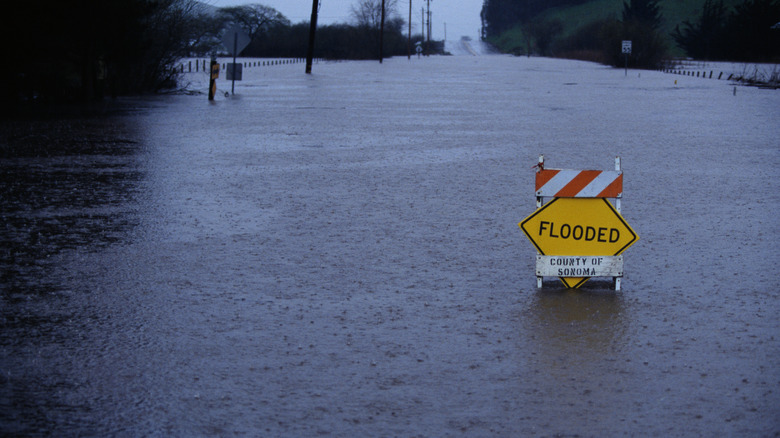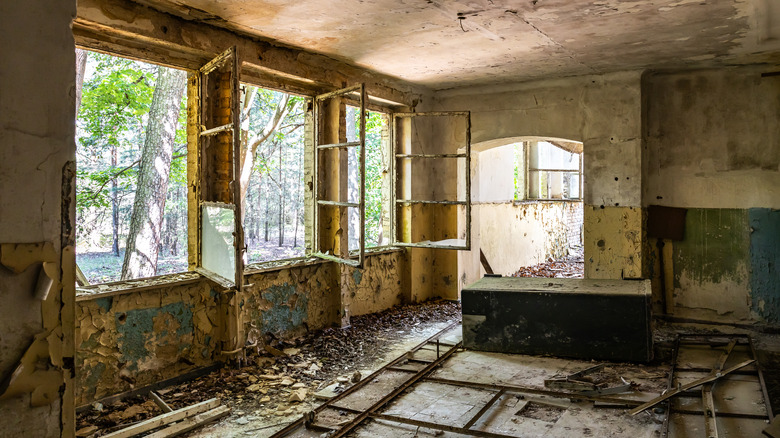Does Homeowner's Insurance Cover Flood Damage? You Might Not Like The Answer
The ins and outs of homeowner's insurance can be confusing, especially when it comes to weather. For instance, standard home insurance policies will cover home repairs after a "weather event," like lighting, hail, or wind. But wind damage due to a "windstorm" such as a hurricane or tornado requires optional windstorm insurance (optional insurance policy add-ons are known as endorsements). Then there's the matter of water damage. If the same windstorm causes your home to flood, the water damage will not be covered by your standard policy or your additional windstorm insurance, but by another endorsement: flood insurance.
Let's say that all you have is standard homeowner's insurance, with no endorsements. If so, flood damage from hurricanes, excessive rainfall, overflowing bodies of water, mudslides, and other natural disasters will not covered. You can purchase this endorsement through your insurance provider or the National Flood Insurance Program (NFIP), which is run by FEMA.
Now, if your home is in a high-risk area for flooding and you have a government-backed mortgage, flood insurance is a requirement. However, if you don't live near a body of water, paying a monthly fee for flood insurance probably hasn't crossed your mind. Maybe it's worth thinking about: The NFIP reports that 99% of all U.S. counties have experienced a flood event over the past two decades, and 40% of its flood claims come from outside high-risk zones.
What does flood insurance cover?
Just to confuse things further, some water damage is covered in standard policies. Sudden or accidental flooding from inside your home, such as a burst pipe or appliance, will be covered — but only if the homeowner isn't negligent (you may be denied if you failed to cover a pipe before a freeze, or failed to fix a broken washing machine). Also covered is water damage from an aforementioned weather event that is not considered flooding (i.e. hail damages your roof and rainwater gets in). Homeowner's insurance will also cover mold damage that results from one of these water damage events, but not mold caused by flooding. Unfortunately, most flood insurance policies do not cover mold caused by flooding, including the policy offered by the NFIP.
So what does flood insurance cover? The National Flood Insurance Program offers policies for both your home's structure and your personal belongings that are damaged due to a flood event. Flood events include mudslides, collapsed land due to flooding or wave erosion, an overflowing body of water, or water that accumulates rapidly. It does not cover items stored outside of your insured building, such as hot tubs, fences, and even cars. It also won't cover any belongings kept in the basement, since it is considered a high-risk area (this does not count installed appliances like water heaters, HVAC units, and washing machines).
Should you get flood insurance?
In 2024, over 100,000 homes in North Carolina were damaged by flooding during Hurricane Helene. Yet 93% of those homes did not have flood insurance. This is not surprising. Most residents of inland mountain towns would never dream hurricanes or flooding would be an issue. But any property can experience a flood event, including those labeled "low-risk" on FEMA's flood map. In fact, flooding is considered five times more likely to occur in your home than fire.
The extent with which a flood can damage a house is catastrophic. Every part of your home's structure can be compromised, including the foundation, walls, ceilings, and floors. It can impair all of your home's electrical, plumbing, and water supply. In other words, it is extremely costly, and may require significant repairs, rebuilding, or relocation. If you home is damaged in a major disaster that affects thousands of residents, you could get compensation from the Disaster Relief Fund, even if you are uninsured. However, it is not a guarantee, and the amount will be unlikely to cover your costs: The average FEMA grant is around $5,000 per household, whereas the average flood claim is over $40,000).
Adding flood insurance to your current policy will save you thousands if disaster strikes. And the likelihood of a disaster affecting your home is steadily rising. The National Center for Environmental Information reports an annual average of 8.5 disaster events per year in previous decades, however, that number has risen to over 20 events per year in the 2020s. So if you haven't considered flood insurance yet, it's probably time to run the numbers.


